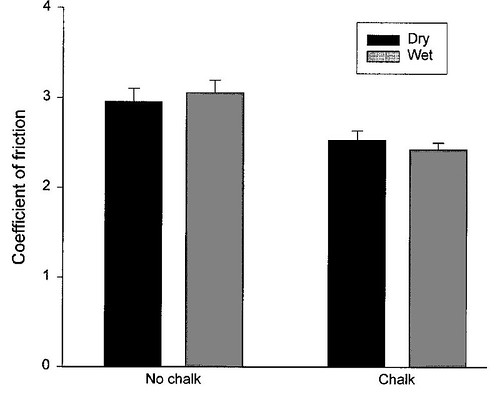We’ve all seen it at the local crag, maybe in the climbing gym or high on an alpine route. Johnny rope-gun gets to the crux of the route, palms sweating from the heat and exertion. He digs into his chalk bag to dry them off before tackling the move. But is all that rock marking chalk helping him? Some say (and have proven) not. In addition, covering your hands in chalk actually reduces the friction your fingers have on rock.

The testing rig.
Yeah I know…try telling Tommy Caldwell that (or anyone at the City of Rocks this weekend) as he’s chalking up for his next speed ascent of El Cap. It’s hard to believe, but the University of Birmingham, UK, did a pretty thorough study (Use of Chalk in Rock Climbing: Sine Qua Non or Myth) of the factors involved in 2001 and came to the conclusion that chalk lowered the coefficient of friction by about 18% (COF: no-chalk=3.00, chalk=2.46). The theory is that chalk creates a granular layer in which the small smooth particles roll on each other…therefore reducing friction.

Whether wet or dry, the use of chalk reduced the amount of friction.
The study went on even further and tested the effects of wet hands, with and without chalk, as well as on different types of rock (granite, sandstone, slate), with the results continuing to support the fact that chalk may be better left at home. While the chalk did help to dry the hands, any residual chalk left on them reduced friction. The study concludes that dry, clean hands offered the most grip and that a towel, instead of a chalk bag, may be better suited for the back of your climbing harness.

Back in the day I refused to use chalk, now I dip like a pro. The only use for a towel on my harness would be to dab up the urine running down my legs because I had no chalk for my sweating hands and I am about to take a whipper:)
Personally I think it makes a big difference, but that is just my opinion.
That study may be true but it ignores the most important reason most climbers use chalk….
You may be scared and not be able to do the move but you can always chalk up! Its a great stall tactic as well.
I think the chalk also helps one grasp the quickdraw with greater holding power.
Personally my favorite stall tactic is to look down at my belayer and say “are you sure this is the way the route goes?” of course there are 25 feet of chalked holds rising above my head to a two bolt anchor.
One other thing I noticed from the above diagram that calls into focus the validity of the above study: I have never been on a climb with armrests and I feel their use would be considered a form of aid! Probably the use of armrests helps reduce sweating and therefore chalk becomes less useful.
Pretty funny, I agree with Dave….the last climb I tried didn’t have an arm rest.
I also agree with Lynn that the towel might have better uses. Personally I use Depends…all the comforts of a towel….without drawing too much attention to the fact that you need a towel to wipe the urine from your leg.
They are pretty much standard with my rack…I have an assortment of alpine pull-ups (that I’ve cut unnecessary portions off to save weight) and standard cragging pull-ups. Sometimes I actually put the chalk down the pull-ups to add to the absorbing power and neutralize some of the acidic smell.
I’m thinking of calling the RD people at Pampers to see if they could work on creating a fully insulated version for winter ski descents….
Carl, is there one of those bar graphs that you have for sprinkling chalk down your britches? I suppose the Coefficient of Friction is most important in that scenario.
It is nice to see that we can turn someones scientific study into comedy, at least it seems funny to me.
you guys are weird. 😕
[…] Steve Romeo has an interesting article up over at TetonAT.com. He points out a study done in 2001 by the University of Birmingham, UK that actually “proved” that chalk gives you less grip, not more. According to the study, […]